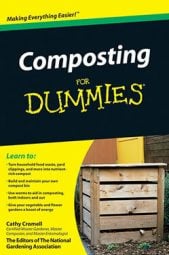You might think composting is hard when you learn that you need to feed your compost carbon and nitrogen. And on top of that, it needs to be in the correct amounts. You're not a chemist (well, unless you are). But adjusting the carbon-to-nitrogen ratio isn't difficult.
You may hear the C:N ratio bandied about in discussions among avid composters. Decomposers that actively break down organic matter prefer a diet containing about 30 times the amount of carbon-rich material as nitrogen-rich material, or a C:N ratio of 30:1. The closer you can come to mixing up 3 parts carbon materials to one part nitrogen materials when you build your pile, the faster the decomposers will consume it and reward you with finished compost.
Actual carbon and nitrogen content in material varies, but typical ranges are included in the following table. Use them as a guide to figure proportions of browns and greens when you're mixing up a batch of compost, but don't stress over precision measurements. Blending carbon and nitrogen ingredients in the "low to middle ranges" of the C:N ratio (such as dry leaves and grass clippings) is a good starting point. Use high-carbon materials (such as cardboard and sawdust) sparingly. After you construct a few piles, you'll get the hang of mixing up your available greens and browns in appropriate amounts.
Nitrogen-rich materials still contain more carbon than nitrogen, as the following table illustrates. So combining one part nitrogen-rich materials with three (as opposed to 30) parts carbon-rich materials can get you to that 30:1 carbon-to-nitrogen ratio.
| Carbon-Rich Ingredients | Carbon to Nitrogen Ratio* | Nitrogen-Rich Ingredients | Carbon to Nitrogen Ratio* |
|---|---|---|---|
| Corn stalks | 60:1 | Chicken manure | 10:1 |
| Corrugated cardboard | 600:1 | Coffee grounds | 20:1 |
| Dry leaves | 40–80:1 | Garden plants and weeds | 20–35:1 |
| Mixed paper products | 200–800:1 | Grass clippings | 10–25:1 |
| Newspaper | 150–200:1 | Hay | 10–25:1 |
| Pine needles | 60–110:1 | Kitchen scraps | 10–50:1 |
| Sawdust, weathered 3 years | 142:1 | Rotted manure | 20–50:1 |
| Sawdust, weathered 2 months | 625:1 | ||
| Straw | 50–150:1 | ||
| Woody plant trimmings | 200–1,300:1 |
* Representative ranges only. Actual carbon to nitrogen ratio varies depending on such factors as plant species and material composition.

